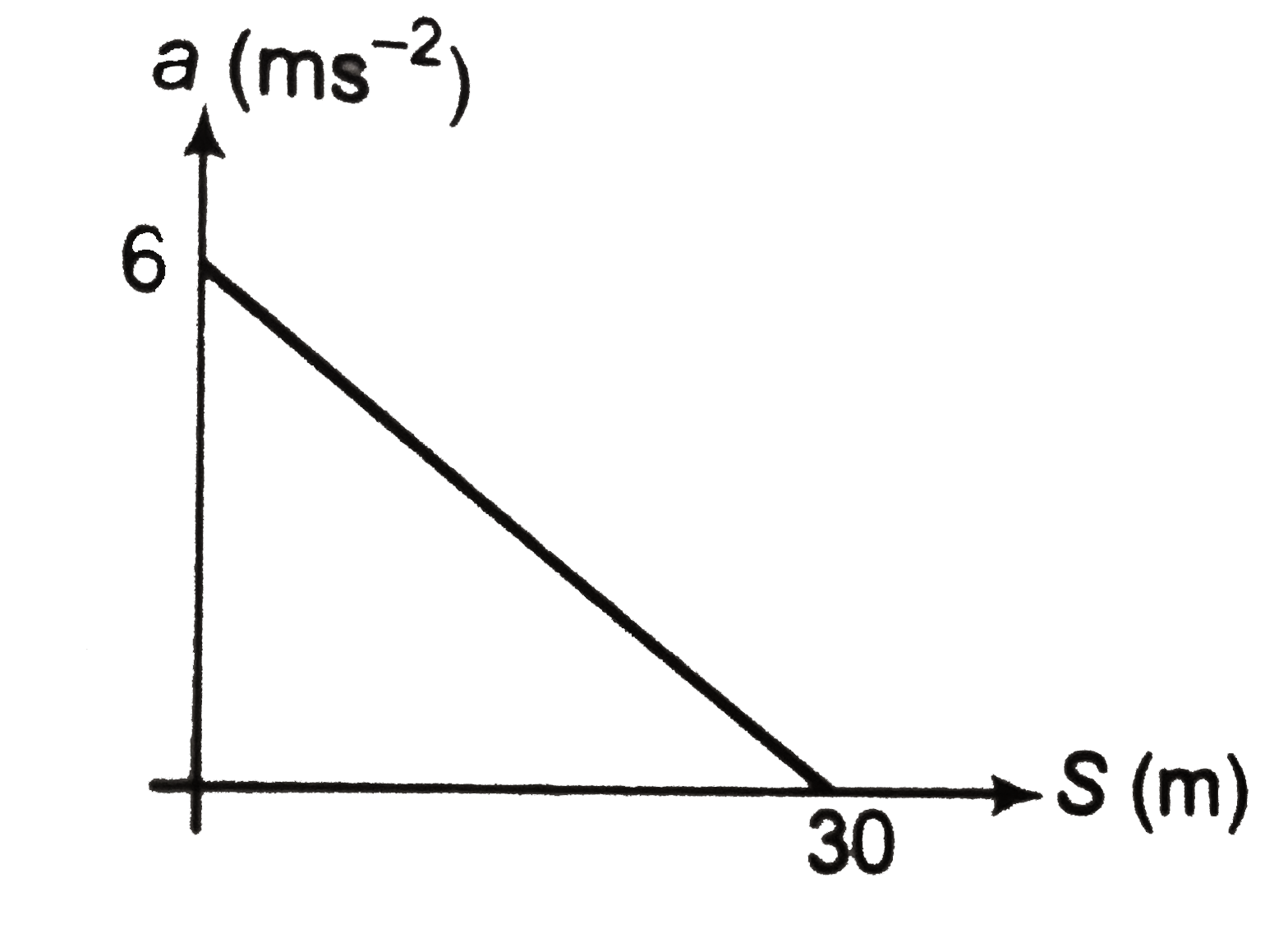A train starts from rest and moves with a constant accelerationof 2.0ms2 for half a minute. The brakes are then applied and the train comes to rest in one minute. Find a. the total distance moved by the train, b. the maximum speed attained by the train and c. the position(s) of the train at half the maximum speed.
Initial velocity
u=0
Acceleration
a=2ms2<br>Letf∈lvelocitybev<br>(beforeapply∈gbreaks)<br>t=30 sec
v=u+at
=0+2xx30
= 60 m/s
a. S_1 = ut+1/2 at^2
= 1/2xx2xx(30)^2
=900m
When breaks are applied
u'=60 m/s
v'=0
t=60 sec (1 min) Deceleration
a'+(v-u)/t
=(0-60)/60=-1m/s^2
S_2= (v^2-u^2)/(2a')
=(0^2-60^2)/(2(-1))ltbrge 1800m
total S=S_1+S_2
=1800+900
=2700m
=2.7m<br>b.Themaxiμmspeed∗ta∈edbytra∈<br>v=60ms<br>c.Halfrthemaxiμmspeed<br>=60/2=30 m/s
Distance
S (v^2-u^2)/(2a')ltbrge (30^2-60^2_)/(2(-1))ltbrge1350 m
Position= 900+1350, 2250
=2.25 km from starting point
Topper's Solved these Questions
- REST AND MOTION : KINEMATICSBook:HC VERMA ENGLISHChapter:REST AND MOTION : KINEMATICSExercise:Question for short Answer
Explore 13 Videos
- REST AND MOTION : KINEMATICSBook:HC VERMA ENGLISHChapter:REST AND MOTION : KINEMATICSExercise:Objective -2
Explore 9 Videos
- PHYSICS AND MATHEMATICSBook:HC VERMA ENGLISHChapter:PHYSICS AND MATHEMATICSExercise:Question for short Answer
Explore 14 Videos
- ROTATIONAL MECHANICSBook:HC VERMA ENGLISHChapter:ROTATIONAL MECHANICSExercise:Questions for short Answer
Explore 21 Videos
Similar Questions
Knowledge Check
A train accelerates from rest at a constant rate α for some time and then it retards to rest at the constant rate β. If the total distance covered by the train is s, then the velocity of the train is
A[α+β2αβ×s]1/2B[α−β2αβ×s]1/2C[αβα+β×s]1/2D[αβα−β×s]1/2A train starting from rest, and moving with uniform acceleration α, acquires a speed v. Then its comes to a stop with uniform retardation β. Then the average velocity of the train is
Av/2Bv/4C(α+β)t/2D(α+β)t/αβ
A train starts from rest and accelerates uniformly at a rate of 2 m s−2 for 10 s. It then maintains a constant speed for 200 s. The brakes are then applied and the train is uniformly retarded and comes to rest in 50 s. Find : (i) the maximum velocity reached, (ii) the retardation in the last 50 S, (iii) the total distance travelled, and (iv) the average velocity of the train.
View SolutionA car accelerates from rest with 2m/s2 on a straight line path and then comes to rest after applying brakes. Total distance travelled by the car is 100 m in 20 seconds. Then, the maximum velocity attained by the car is
View SolutionA train starts from rest and accelerates uniformly at 100 m minute−2 for 10 minutes. Find the velocity acquired by the train. It then maintains a constant velocity for 20 minutes. The brakes are then applied and the train is uniformly retarded. It comes to rest in 5 minutes. Draw a velocity-time graph and use it to find :
(i) the retardation in the last 5 minutes,
(ii) total distance travelled, and
(iii) the average velocity of the train.
View SolutionA train accelerates from rest at a constant rate a for time t1and then it retards at the constant rate b for time t2 then comes to rest. Find the ratio t1/t2.
View SolutionA train starting from a railway station and moving with uniform acceleration attains a speed 40km/h in 10 minutes. Find its acceleration.
View SolutionA trian starts from rest from a station with acceleration 0.2ms2 on a straight track and after attaining maximum speed it comes to rest on another station due to retardation of 0.4ms2. If total time spent is half an hour, then distance between two stations is (Neglect length of train) :-
View Solution


